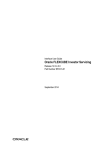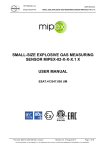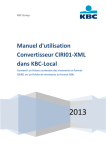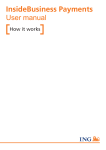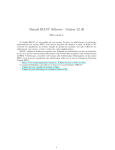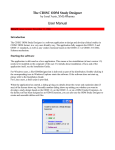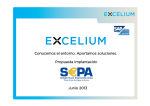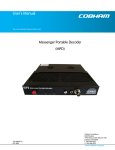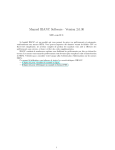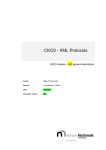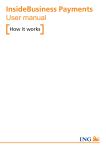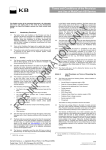Download - ING Belgium
Transcript
Financial S
upp
ly C
hai
n
SEPA
XML format guide for Belgium
SEPA Credit Transfer (SCT)
version March 2014
www.ing.be/sepa
Introduction1
Frequently asked questions
2
How should the ‘CreationDateTime’ be correctly formatted?
2
How should the ‘InitiatingParty’ be correctly formatted?
2
How should the table above be interpreted
and what do the “+” and [#..#] signs mean?
3
What is the ‘BatchBooking’?
4
What is the ‘RequestedExecutionDate’?
5
ING Appendix to Febelfin SEPA CREDIT TRANSFER
6
Examples
9
CIRI01 to XML mapping
16
Reference Information
17
Useful links
18
Introduction
The purpose of this document is to help you to understand and use the XML
format for your SEPA transactions.
Febelfin has published the “XML Message for credit transfer Initiation” based on
the European Payments Council (EPC) Rulebooks.
Although the guidelines should contain all information to create a correct financial
message, we do believe more information is necessary to come to an efficient and
smooth transfer with a satisfying end result.
Our description is based on the standard message ISO20022 CustomerCredit
TransferInitiation <pain.001.001.03>, supplemented with the Febelfin Guidelines
for XML Messaging and the ING appendix. The ISO 20022 standard puts some
rules and constraints to the use of standard XML messaging.
The ING appendix, which has to be considered as a complementary document to
the Febelfin guidelines, gives you more details about what is supported or not
by ING. The ING Appendix takes priority over the Febelfin XML Implementation
Guidelines.
Both the Febelfin document and the ING appendix must be read next to each
other and are the key of a successful migration.
An additional success factor is the use of your current knowledge to achieve a
correct SEPA migration. In this document we also want to give you information on
how to create XML elements based on your CIRI01. We conclude the information
on how ING can help you with testing.
We would like to draw your attention to the fact that ING cut-off times must be
respected for a smooth processing of your transactions.
XML format guide for Belgium SEPA Credit Transfer (SCT) 1
Frequently asked questions
How should the ‘CreationDateTime’ be correctly formatted?
Definition: Date and Time at which the message was created.
XML Tag: <CreDtTm>
Occurrences: [1..1]
Format: YYYY-MM-DDThh:mm:ss
Example: <CreDtTm>2011-08-24T09:40:30</CreDtTm>
If this format is not respected the payment instruction will be rejected.
How should the ‘InitiatingParty’ be correctly formatted?
Definition: Party initiating the payment. This can be either the debtor or a party
initiating the payment on behalf of the debtor.
XML Tag: <InitgPty>
Occurrences: [1..1]
Format: T
his message item consists of the following elements:
1.8
[1..1]
++
InitiatingParty
<InitgPty>
[0..1]
+++
Name
<Nm>
70
[0..1]
+++
Identification
<Id>
[1..1]
++++
OrganisationIdentification
<OrgId>
[0..1]{Or
+++++
BICOrBEI
<BICorBEI>
11
[0..1] Or}
+++++
Other
<Othr>
[1..1]
++++++
Identification
<Id>
35
[1..1]
++++++
Issuer
<Issr>
35
Rules:
• Either Name or Identification or both must be used. Name is limited to 70
characters.
• For Belgian companies, Identification (within Other) must contain the Enterprise
Number (10 digits) and as Issuer “KBO-BCE”.
• If Identification is used, then OrganisationIdentification must be used
(mandatory).
• When OrganisationIdentification is used, we can choose between two optional
sub-elements: BICOrBEI, or Other. If Other is used, Identification and Issuer
must be used, as they are both mandatory.
XML format guide for Belgium SEPA Credit Transfer (SCT) 2
How should the table above be interpreted and what do the “+”
and [#..#] signs mean?
The «+» sign refers to the level where the element figures in the xml-structure:
The [#..#] sign indicates whether an item of the message is mandatory and how
many times the element can be repeated. The number of occurrences is shown
between square brackets.
• [0..1] shows that the element can be present 0 times or 1 time.
Element is optional.
• [1..1] shows that the element can be present only 1 time.
Element is mandatory.
• [1..n] shows that the element can be present 1 to n times.
Element is mandatory.
‘n’ is sometimes shown as ‘∞’, which stands for infinite.
The interpretation of the status of the data is influenced by an indication of
“Or”. In that case two different sub-children can be used for one child. Both
are correct but have another impact and consequence. The two different
sub-children will be indicated in the occurrence as follows:
[0..1]{Or
[0..1] Or}
Illustration with Initiating Party:
2nd level (++)
1st level (+)
The Initiating Party on level 2 (++) is mandatory [1..1]
3rd level (+++)
Either Name (+++) or Identification (+++) or both must be used and are optional [0..1];
because Initation Party is mandatory, at least one of both should figure in the xml.
4th level (++++)
If the Identification (+++) is used, the OrganisationIdentification (++++) must be
used, for it is mandatory [1..1].
XML format guide for Belgium SEPA Credit Transfer (SCT) 3
For OrganisationIdentification (++++), there is a choice between one of the
two optional elements: BICOrBEI (+++++), or Other (+++++). There should
figure at least one of these 2, but not both (there is an {or} between them;
the tag OrganisationIdentification ++++ above is mandatory, but has maximum
1 occurrence: [1..1])
1st Possibility: BICOrBEI (+++++) can be used (this is a code allocated to
organisations by the ISO 9362 Registration Authority, e.g. for non-Belgian
companies).
5th level (+++++)
2nd Possibility: If Other (+++++) is used instead of BICOrBEI, the Identification
(++++++) and [1..1]. Issuer (++++++) must be used, for they are mandatory [1..1].
5th level (+++++)
6th level (++++++)
For Belgian companies, Identification (within Other) must contain the Enterprise
Number (10 digits) and as Issuer “KBO-BCE”.
What is the ‘BatchBooking’?
The use of the batch booking functionality is optional but recommended by ING.
This will allow the creator of the file to define for each file or even for each batch
within a file, if it will be debited globally or individually from the ordering account.
The parameter will apply to all transactions (CreditTransferTransactionInformation)
contained in the batch (PaymentInformation).
When a global debit is requested, this will by default mean the debit of one global
amount in the account information and CODA reporting.
On request, ING can supply detailed information for such batches (MECT – Multiple
SEPA Credit Transfers) in the CODA reporting.
Should you wish to receive detailed reporting information please contact our
Electronic Banking Support (EBS) Team at least four working days before the
implementation date.
XML format guide for Belgium SEPA Credit Transfer (SCT) 4
Usage rule:
• If not present, the file will be by default considered to be batch booked.
• If present and contains “true”, <BtchBookg>true</BtchBookg>, batch booking
is requested.
• If present and contains “false”, <BtchBookg>false</BtchBookg>, booking per
transaction is requested.
The Batch Booking tag is characterized by <BtchBookg> in PaymentInformation
block (index 2.3).
Important Remark on the PaymentInformation Block:
Regardless of whether the batch booking value is “True” or “False”, you must
group your transactions whenever possible under the same PaymentInformation
block. This avoids unnecessary impact on your reporting: exponentially increasing
size of the reporting files (as each transaction will be reported separately), and
the risk of generating errors.
If all the data of the debit information contained in the PaymentInformation
block are the same for a group of transactions, using it once is enough and those
transactions can be grouped under one PaymentInformation block.
If you want the reporting at transaction level instead of at payment information
level, this is possible within the set-up of the ING CODA product, not via the XML
format.
What is the ‘RequestedExecutionDate’?
Definition: Date at which the initiating party asks the Debtor’s Bank to process the
payment. This is the date on which the debtor’s account(s) is (are) to be debited.
XML Tag: <ReqdExctnDt>
Occurrences: [1..1]
Format: YYYY-MM-DD
Example: <ReqdExctnDt>2010-12-18</ReqdExctnDt>
ING Rule:
• When batch booking is requested (2.3 batch booking contains “true”), the
date is limited to six months in the future and 5 days in the past.
• When single booking is requested (2.3 batch booking contains “false”), the
date is limited to one year in the future and 5 days in the past.
It is important to take the ING cut-off times into consideration when using the
‘RequestedExecutionDate’ tag. If ING cut-off times are not respected, the execution
time of the payment can be altered.
XML format guide for Belgium SEPA Credit Transfer (SCT) 5
ING Appendix to Febelfin SEPA
CREDIT TRANSFER
(Appendix version 2.1 – 30.08.2010)
ING supports the “XML message for credit transfer Initiation” – implementation
guidelines – published by Febelfin, the Belgian Financial Sector Federation. The
document can be found in the “Febelfin standards for distance banking” via the
following link:
http://www.febelfin.be/en/standards-distance-banking
You are advised to always use the latest version published. It is the European
Payments Council (EPC) that decides if changes are required.
This annex to the Febelfin document aims to provide details about the actual
interpretation of these guidelines by ING for SEPA payments (SEPA Direct Debit)
initiated in Belgium.
Only Belgian creditor accounts are in scope. Electronic channels: Swiftnet or FTP
or Isabel6 only.
The description is based on the standard message ISO 20022 Customer
CreditTransferInitiation <pain.001.001.03>.
The number of transactions is limited to a maximum of 50.000 transactions per file.
List of items with ING specific instruction
How to read this list
Febelfin XML Implementation Guidelines and the ING Appendix are two documents
that are useful for the customer who wants to migrate easily to SEPA products.
These documents should be read next to each other as the ING Appendix refers
to the chapters and numbering (index) of the Febelfin XML Implementation
Guidelines. The ING Appendix takes priority over the Febelfin XML Implementation
Guidelines.
The first two figures mentioned below represent the index. It is the number
referring to the corresponding description in the ISO 20022 XML Message Definition
Report for Payment Standards – Initiation.
“Not supported” means that it is ignored by ING (no blocking factor but is ignored
for execution and reporting).
2.4 Number of transactions (Batch level ‘B’)
Not supported
2.5 Control sum (Batch level ‘B’)
Not supported
2.17 Requested Execution date (Batch level ‘B’)
•
When batch booking is requested (2.3 batch booking contains “true”),
the date is limited to six months in the future and 5 days in the past.
• When single booking is requested (2.3 batch booking contains “false”),
the date is limited to one year in the future and 5 days in the past.
XML format guide for Belgium SEPA Credit Transfer (SCT) 6
2.19 Debtor (Batch level ‘B’)
Identification is not supported
2.20 Debtor Account (Batch level ‘B’)
“Currency of the account” is not supported
2.23 Ultimate Debtor (Batch level ‘B’)
Not supported
2.70 Ultimate Debtor (Transaction level (T’)
Not supported
2.79 Creditor (Transaction level ‘T’)
Identification is not supported
2.81 Ultimate Creditor (Transaction level ‘T’)
Not supported
2.86 Purpose (Transaction level ‘T’)
Not supported
Legend
M
B1
T1
T2
B2
T3
T4
XML format guide for Belgium SEPA Credit Transfer (SCT) 7
Level (+)
CUSTOMERCREDITTRANSFERINITIATION
Message item
Occur.
1
GroupHeader
[1..1]
2
MessageIdentification
[1..1]
2
CreationdateTime
[1..1]
2 NumberOfTransactions
[1..1]
2
ControlSum
[0..1]
2
InitiatingParty
[1..1]
1
PaymentInformation
[1..n]
2
PaymentInformationIdentification
[1..1]
2
PaymentMethod
[1..1]
2
BatchBooking
[0..1]
2
NumberOfTransactions
[0..1]
2
PaymentTypeInformation
[0..1]
2
RequestedExecutionDate
[1..1]
2
Debtor
[1..1]
2
DebtorAccount
[1..1]
2
DebtorAgent
[1..1]
2 ChargeBearer
[0..1]
2
CreditTransferTransactionInformation
[1..n]
3
PaymentIdentification
[1..1]
3
Amount
[1..1]
3
UltimateDebtor
[0..1]
3
CreditorAgent
[0..1]
3
Creditor
[1..1]
3
CreditorAccount
[0..1]
3
UltimateCreditor
[0..1]
3
RemittanceInformation
[0..1]
XML format guide for Belgium SEPA Credit Transfer (SCT) 8
MESSAGE LEVEL (‘M’)
BATCH LEVEL (‘B’)
TRANSACTION LEVEL (‘T’)
Examples
SEPA Credit Transfer with two batches of two transactions
The following example describes a SEPA Credit Transfer containing two different
batches of two transactions for a total amount of EUR 4000.00.
The first batch contains a transaction for an amount of EUR 1000.00 and a second
transaction for an amount of EUR 500.00. Batch booking “false” is requested as
it concerns suppliers’ transactions (SUPP).
The second batch contains a transaction for an amount of EUR 500.00 EUR and
a second transaction for an amount of EUR 2000.00. Batch booking “true” is
requested as it concerns salary payments (SALA).
XML format guide for Belgium SEPA Credit Transfer (SCT) 9
XML format guide for Belgium SEPA Credit Transfer (SCT) 10
XML format guide for Belgium SEPA Credit Transfer (SCT) 11
XML format guide for Belgium SEPA Credit Transfer (SCT) 12
XML format guide for Belgium SEPA Credit Transfer (SCT) 13
XML format guide for Belgium SEPA Credit Transfer (SCT) 14
XML format guide for Belgium SEPA Credit Transfer (SCT) 15
CIRI01 to XML mapping
The table below shows the mandatory and recommended elements only. The
purpose of this information is to show you the link between the XML format
and the CIRI01 format.
Index
Message Item
<XML Tag>
CIRI01 functional
equivalent
1.0
GroupHeader
<GrpHdr>
Mandatory
1.1
MessageIdentification
<MsgId>
Mandatory
1.2
CreationDateTime
<CreDtTm>
Mandatory
Rec 0 pos 6-11
1.6
Number of Transactions
<NbOfTxs>
Mandatory
1.8
InitiatingParty
<InitgPty>
Mandatory
2.0
PaymentInformation
<PmtInf>
Mandatory
2.1
PaymentInformationIdentification
<PmtInfId>
Mandatory
Rec 0 pos 118-127
2.2
PaymentMethod
<PmtMtd>
Mandatory
2.3
BatchBooking
<BtchBookg>
Recommended
2.17
RequestedExecutionDate
<ReqdExctnDt>
Mandatory
Rec 0 pos 17-22
2.19
Debtor
<Dbtr>
Mandatory
Rec 0 pos 39-116
2.20
Debtor Account
<DbtrAcct>
Mandatory
Rec 0 pos 27-38
2.21
Debtor Agent
<DbtrAgt>
Mandatory
2.27
CreditTransferTransactionInformation
<CdtTrfTxInf>
Mandatory
2.28
PaymentIdentification
<PmtId>
Mandatory
2.30
EndToEndIdentification
<EndToEndId>
Mandatory
2.42
Amount
<Amt>
Mandatory
2.43
InstructedAmount
<InstdAmt>
Mandatory
Rec 1 pos 36-47
2.79
Creditor
<Cdtr>
Mandatory
Rec 1 pos 48-73
2.80
Creditor Account
<CdtrAcct>
Recommended
Rec 1 pos 24-35
2.98
Remittance Information
<RmtInf>
Recommended
Rec 1 pos 75-127
In CIRI01, there was no possibility to request a global debit or a single debit in the
file content. The upload of a file was considered to be a global debit for that file.
With XML, you can choose between a global debit and a debit on transaction
basis by using the batch booking parameter.
XML format guide for Belgium SEPA Credit Transfer (SCT) 16
Reference Information
The table below shows you where to retrieve information related to references.
Index
Message Item
Description
1.1
MessageIdentification
This mandatory reference is determined by you, being the initiating
party, and sent to your bank in order to identify the message.
It is recommended to limit the max. length to 30 characters.
This reference will be not be present in your CODA reporting.
2.1
PaymentInformationIdentification
This mandatory reference is determined by you, being the initiating
party, in order to unambiguously identify the payment information
block within the message.
It is recommended to limit the max. length to 30 characters.
This reference is used when <BtchBookg> “true” is requested
(for MECT).
It is present in your CODA reporting in the reference field of the
global amount.
2.29
InstructionIdentification
This optional reference is determined by you, being the initiating
party, and sent to your bank in order to identify the transaction.
As this identification is a reference between the Initiator and the
Debtor’s Bank, it is not forwarded to the Creditor’s Bank.
2.30
EndToEndIdentification
This mandatory reference is determined by you, being the initiating
party, in order to unambiguously identify the transaction. This
identification is passed on, unchanged, throughout the entire
end-to-end chain.
This reference is present in your CODA reporting at the detail level.
For SEPA Credit Transfers, this unique identification is passed on
to the beneficiary.
XML format guide for Belgium SEPA Credit Transfer (SCT) 17
Useful links
Febelfin: standards for distance banking
http://www.febelfin.be/en/standards-distance-banking
ISO20022 – CustomerCreditTransferInitiation
http://www.iso20022.org
European Payments Council (EPC)
http://www.europeanpaymentscouncil.eu/content.cfm?page=sepa_credit_transfer
Format Validation Tool
The User Manual is available on the website via this link:
http://www.ingsepa.com/formatvalidationtool/en
ING Belgium SA/nv – Bank – Registered Office: Marnixlaan 24, B-1000 Brussels – Brussels RPM/RPR– VAT BE 0403.200.393 – IBAN: BE453109 1560 2789.
Publisher: Inge Ampe – Cours Saint-Michel 60, B-1040 Brussels – 705117E – 03/14 – © Editing Team & Graphic Studio – Marketing ING Belgium






















